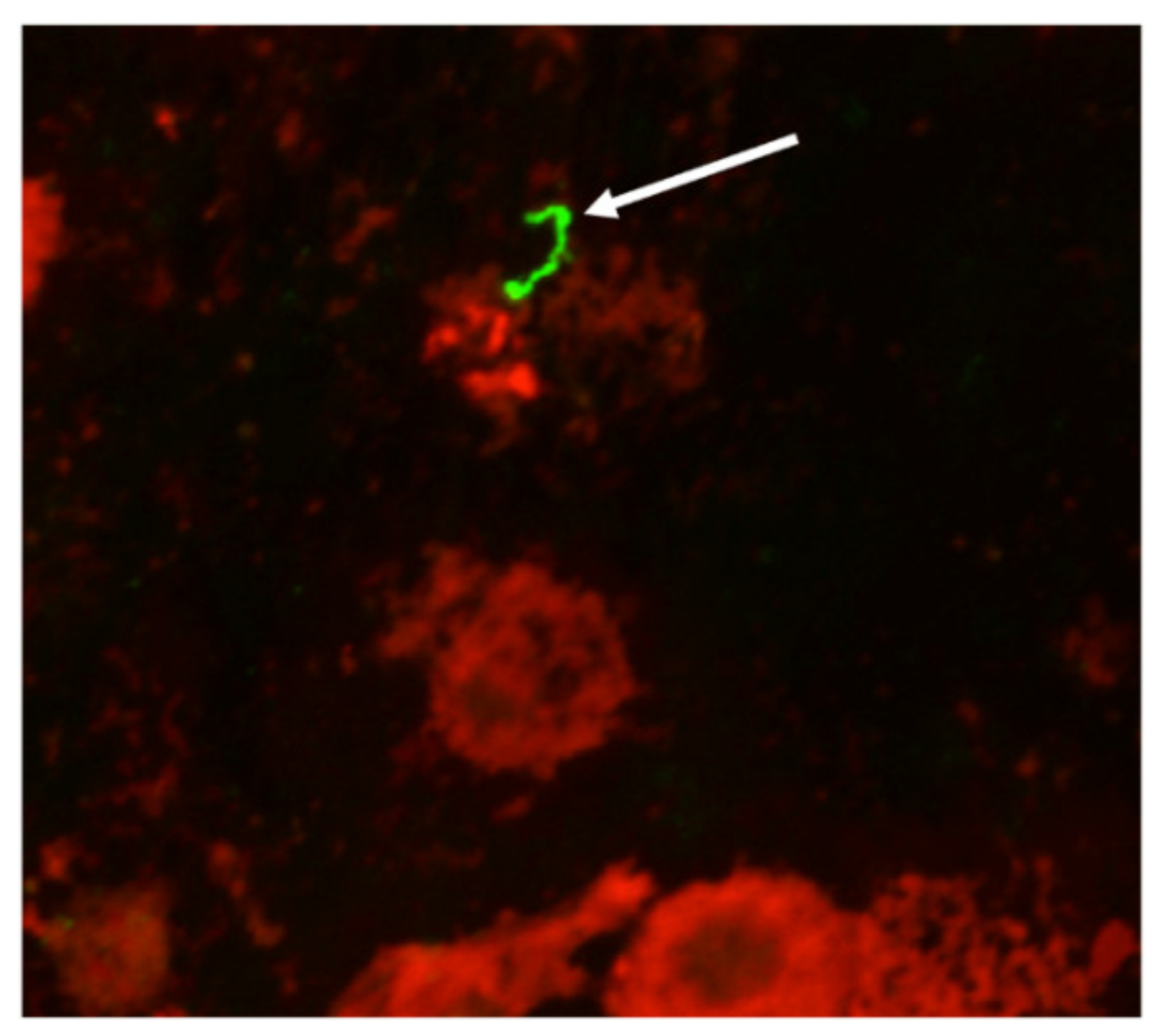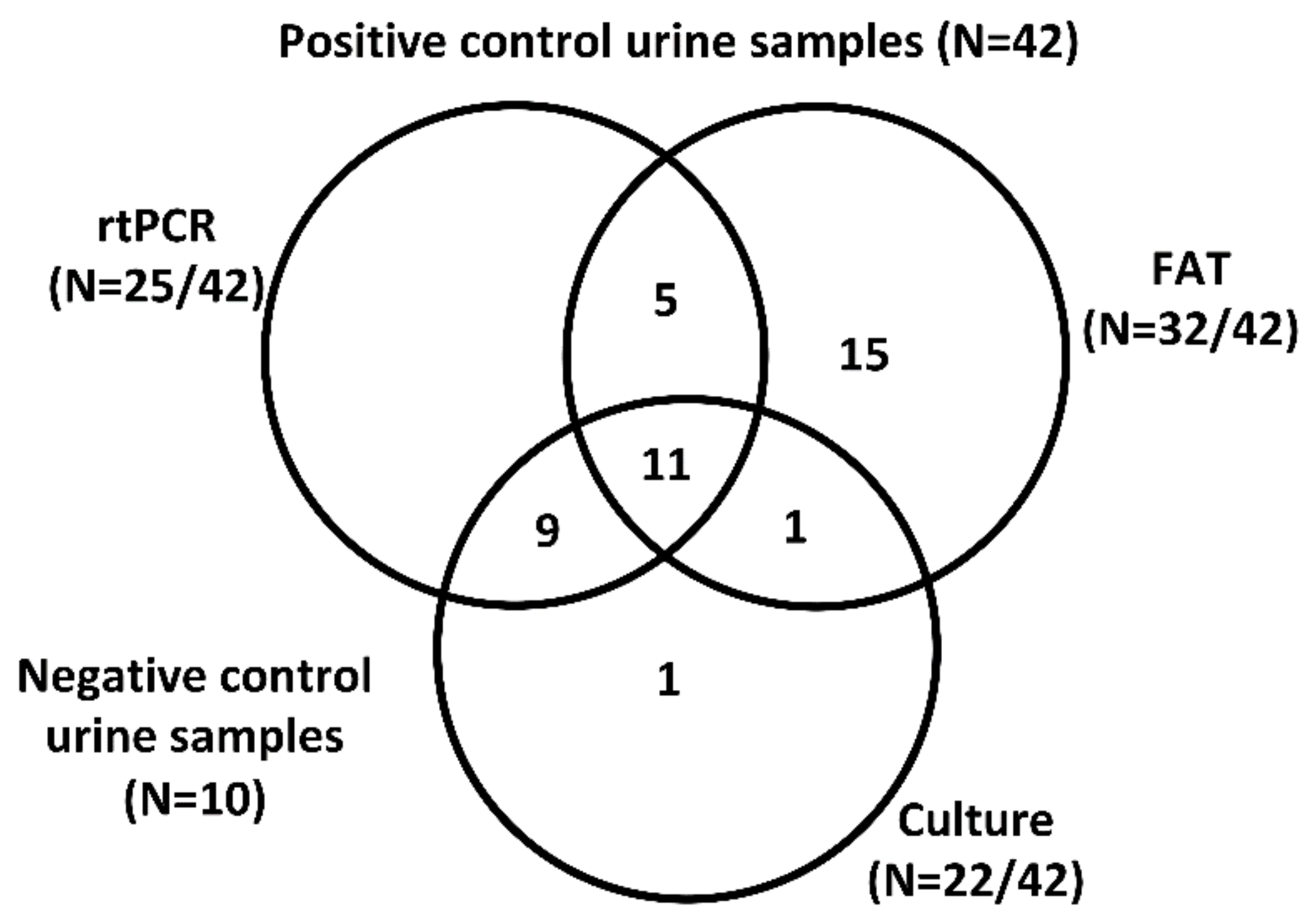Comparison of Real-Time PCR, Bacteriologic Culture and Fluorescent Antibody Test for the Detection of Leptospira borgpetersenii in Urine of Naturally Infected Cattle
Abstract
1. Introduction
2. Materials and Methods
3. Results
4. Discussion
5. Conclusions
Author Contributions
Funding
Acknowledgments
Conflicts of Interest
References
- Bharti, A.R.; Nally, J.E.; Ricaldi, J.N.; Matthias, M.A.; Diaz, M.M.; Lovett, M.A.; Levett, P.N.; Gilman, R.H.; Willig, M.R.; Gotuzzo, E. Leptospirosis: A zoonotic disease of global importance. Lancet Infect. Dis. 2003, 3, 757–771. [Google Scholar] [CrossRef]
- Faine, S.; Adler, B.; Bolin, C.; Perolat, P. Leptospira and Leptospirosis, 2nd ed.; MediSci: Melbourne, VIC, Australia, 1999. [Google Scholar]
- Torgerson, P.R.; Hagan, J.E.; Costa, F.; Calcagno, J.; Kane, M.; Martinez-Silveira, M.S.; Goris, M.G.; Stein, C.; Ko, A.I.; Abela-Ridder, B. Global burden of leptospirosis: Estimated in terms of disability adjusted life years. PLoS Negl. Trop. Dis. 2015, 9, e0004122. [Google Scholar] [CrossRef]
- Ellis, W.A. Animal leptospirosis. Curr. Top. Microbiol. Immunol. 2015, 387, 99–137. [Google Scholar] [CrossRef] [PubMed]
- Juvet, F.; Schuller, S.; O’Neill, E.; O’Neill, P.; Nally, J. Urinary shedding of spirochaetes in a dog with acute leptospirosis despite treatment. Vet. Rec. 2011, 169, 187. [Google Scholar] [CrossRef] [PubMed]
- Chow, E.; Deville, J.; Nally, J.; Lovett, M.; Nielsen-Saines, K. Prolonged Leptospira urinary shedding in a 10-year-old girl. Case Rep. Pediatr. 2012, 2012. [Google Scholar] [CrossRef] [PubMed][Green Version]
- Mauro, T.; Harkin, K. Persistent leptospiruria in five dogs despite antimicrobial treatment (2000–2017). J. Am. Anim. Hosp. Assoc. 2019, 55, 42–47. [Google Scholar] [CrossRef] [PubMed]
- Ellis, W.A.; O’Brien, J.J.; Cassells, J. Role of cattle in the maintenance of Leptospira interrogans serotype Hardjo infection in Northern Ireland. Vet. Rec. 1981, 108, 555–557. [Google Scholar] [CrossRef] [PubMed]
- Babudieri, B. Animal reservoirs of leptospires. Ann. N. Y. Acad. Sci. 1958, 70, 393–413. [Google Scholar] [CrossRef] [PubMed]
- Martins, G.; Loureiro, A.P.; Hamond, C.; Pinna, M.H.; Bremont, S.; Bourhy, P.; Lilenbaum, W. First isolation of Leptospira noguchii serogroups Panama and Autumnalis from cattle. Epidemiol. Infect. 2015, 143, 1538–1541. [Google Scholar] [CrossRef] [PubMed]
- Miller, D.; Wilson, M.; Beran, G. Survey to estimate prevalence of Leptospira interrogans infection in mature cattle in the United States. Am. J. Vet. Res. 1991, 52, 1761–1765. [Google Scholar] [PubMed]
- Nally, J.E.; Hornsby, R.L.; Alt, D.P.; Bayles, D.; Wilson-Welder, J.H.; Palmquist, D.E.; Bauer, N.E. Isolation and characterization of pathogenic leptospires associated with cattle. Vet. Microbiol. 2018, 218, 25–30. [Google Scholar] [CrossRef] [PubMed]
- Rajeev, S.; Ilha, M.; Woldemeskel, M.; Berghaus, R.D.; Pence, M.E. Detection of asymptomatic renal Leptospira infection in abattoir slaughtered cattle in southeastern Georgia, United States. SAGE Open Med. 2014, 2, 2050312114544696. [Google Scholar] [CrossRef] [PubMed]
- Guitian, J.; Thurmond, M.C.; Hietala, S.K. Infertility and abortion among first-lactation dairy cows seropositive or seronegative for Leptospira interrogans serovar Hardjo. J. Am. Vet. Med. Assoc. 1999, 215, 515–518. [Google Scholar] [PubMed]
- Rojas, P.; Monahan, A.; Schuller, S.; Miller, I.; Markey, B.; Nally, J. Detection and quantification of leptospires in urine of dogs: A maintenance host for the zoonotic disease leptospirosis. Eur. J. Clin. Microbiol. Infect. Dis. 2010, 29, 1305–1309. [Google Scholar] [CrossRef]
- Ahmed, A.; Engelberts, M.F.; Boer, K.R.; Ahmed, N.; Hartskeerl, R.A. Development and validation of a real-time PCR for detection of pathogenic Leptospira species in clinical materials. PLoS ONE 2009, 4, e7093. [Google Scholar] [CrossRef]
- Wagenaar, J.; Zuerner, R.L.; Alt, D.; Bolin, C.A. Comparison of polymerase chain reaction assays with bacteriologic culture, immunofluorescence, and nucleic acid hybridization for detection of Leptospira borgpetersenii serovar Hardjo in urine of cattle. Am. J. Vet. Res. 2000, 61, 316–320. [Google Scholar] [CrossRef]
- Manual of Diagnostic Tests and Vaccines for Terrestrial Animals 2019. Available online: https://www.oie.int/standard-setting/terrestrial-manual/access-online/ (accessed on 13 May 2020).


| Culture | FAT | ||
|---|---|---|---|
| rtPCR | Percent Observed Agreement | 86.5% | 51.9% |
| (20 + 25)/52 | (16 + 11)/52 | ||
| Cohen’s Kappa Value | 0.73 | 0.04 | |
| Substantial Agreement | Slight Agreement | ||
© 2020 by the authors. Licensee MDPI, Basel, Switzerland. This article is an open access article distributed under the terms and conditions of the Creative Commons Attribution (CC BY) license (http://creativecommons.org/licenses/by/4.0/).
Share and Cite
Nally, J.E.; Ahmed, A.A.A.; Putz, E.J.; Palmquist, D.E.; Goris, M.G.A. Comparison of Real-Time PCR, Bacteriologic Culture and Fluorescent Antibody Test for the Detection of Leptospira borgpetersenii in Urine of Naturally Infected Cattle. Vet. Sci. 2020, 7, 66. https://doi.org/10.3390/vetsci7020066
Nally JE, Ahmed AAA, Putz EJ, Palmquist DE, Goris MGA. Comparison of Real-Time PCR, Bacteriologic Culture and Fluorescent Antibody Test for the Detection of Leptospira borgpetersenii in Urine of Naturally Infected Cattle. Veterinary Sciences. 2020; 7(2):66. https://doi.org/10.3390/vetsci7020066
Chicago/Turabian StyleNally, Jarlath E., Ahmed A. A. Ahmed, Ellie J. Putz, Debra E. Palmquist, and Marga G. A. Goris. 2020. "Comparison of Real-Time PCR, Bacteriologic Culture and Fluorescent Antibody Test for the Detection of Leptospira borgpetersenii in Urine of Naturally Infected Cattle" Veterinary Sciences 7, no. 2: 66. https://doi.org/10.3390/vetsci7020066
APA StyleNally, J. E., Ahmed, A. A. A., Putz, E. J., Palmquist, D. E., & Goris, M. G. A. (2020). Comparison of Real-Time PCR, Bacteriologic Culture and Fluorescent Antibody Test for the Detection of Leptospira borgpetersenii in Urine of Naturally Infected Cattle. Veterinary Sciences, 7(2), 66. https://doi.org/10.3390/vetsci7020066





